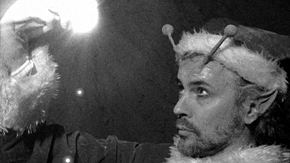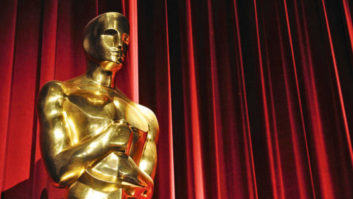
One of our favorite martians, Wayne Coyne
Look, maybe this isn’t the way to get into the Flaming Lips. Yeah, I know — you’ve heard they’re funny and strange, and you’ve wanted to check ’em out. Maybe someone told you about some of the Oklahoma City band’s past exploits — like Zaireeka, a concept album meant to be played simultaneously on four different sound systems, or their related experiments with cars and boomboxes, again involving multiple sources playing music. Maybe you’ve stumbled across one of their truly odd videos for one of their non-hits, or at a party some prankster cranked up a track or two from one of their bizarre recent albums, Yoshimi Battles the Pink Robots and At War With the Mystics: places where off-kilter pop meets edgy electronic music, rock riffing and the most lyrically twisted musings this side of Zappa. But you still may not be ready for Christmas on Mars.
How to describe the indescribable? Christmas on Mars is a 90-minute holiday fable set in a small, lonely space station on Mars. The handful of bored and troubled folks therein (including Flaming Lips bandmembers) confront various unusual situations in the space station and in their minds, and there’s also a rather Santa-like, but silent, alien — played by Lips founder/leader/film director Wayne Coyne — who magically appears and becomes a pivotal figure. Ah, but that brief synopsis doesn’t even hint at the suffocating claustrophobia and ennui that permeates life at the space station, or the grotesque science experiments that are taking place there, or the surrealistic visions of marching bands with female genitalia where their faces should be (I kid you not). Between the Labia Band and the unrelenting profanity, this is not one for the kids.
Production values are…well…limited. This is a proudly low-budget affair, shot mostly in black and white (16mm and video) on funky sets constructed at the Flaming Lips’ “compound” in Oklahoma City. There are scratches on some of the footage to give it the look of a cheesy ’50s sci-fi movie, but it’s not all put-on. It’s genuinely creepy and disturbing — and uplifting at the end. It’s the feel-weird holiday movie of 2008! It had limited theatrical showings in the fall, but is already available on DVD (with soundtrack CD included) for future generations to puzzle over. Seven years in the making, Christmas on Mars was an outgrowth of Coyne’s longtime fascination with film — previously indulged in a dozen or so Flaming Lips videos, mostly shot with collaborator Bradley Beesley, who also worked on Mars. It was made in small chunks through the years, edited mostly in Final Cut Pro, with the soundtrack recorded and mixed (in stereo and 5.1) at Tar Box Road, the upstate New York studio of their regular producer/engineer, Dave Fridmann.
The score, a collaboration by the Lips — particularly Steven Drozd, who’s also the leading man in the film — offers a moody blend of appropriately spacey, minimalist electronic/synth pulses and music; haunting celestial voices and orchestral textures; and no conventional songs or rock instruments. Music and effects were part and parcel of the same thing, Coyne says. “We’d go in some days and do sound effects as a group, making 10 different computer programs of distortion actually sound like a broken refrigerator. Or maybe we’d record that refrigerator or the microwave door closing. Other times we’d sit there and make music as the film was showing on screen, going through countless variations.
“Effects are nothing new to us — there’s always been an element of that in what we do,” he continues. “What is a sound effect versus what’s just a cool sound? From day one we’ve experimented like that — throw some stuff in the background and suddenly you’ve got this atmosphere, which is helping to tell some strange, abstract story.”
Coyne says that Fridmann’s control room is equipped with all the synths and computer programs they needed, “and Steven also has a little Pro Tools setup at his house with endless plug-ins. I don’t even know the names of most of them. I know he has a couple of the Miroslav [Philharmonik] programs where you get a lot of harp and string sounds and big, dense orchestral things. That wasn’t even around when we started in 2001, so as the years went along, he started to use it more and more.
“We checked out so many programs, and in most of them there are probably 10 things in their sound banks that are awesome of the half-million things that are in there,” he says with a laugh. “So you dig through and find a couple of unique combinations and run it through a couple of distortion devices or flangers or something that blends effects. But I would say there was never really a method [to the sound creation].
“We also got a few effects from sound libraries and even from Garage Band. To me, it didn’t matter if it was a sound we found in two seconds online or a sound that took us three weeks in Dave’s studio; the whole thing is a combination of those. Anything that would work we used.”







